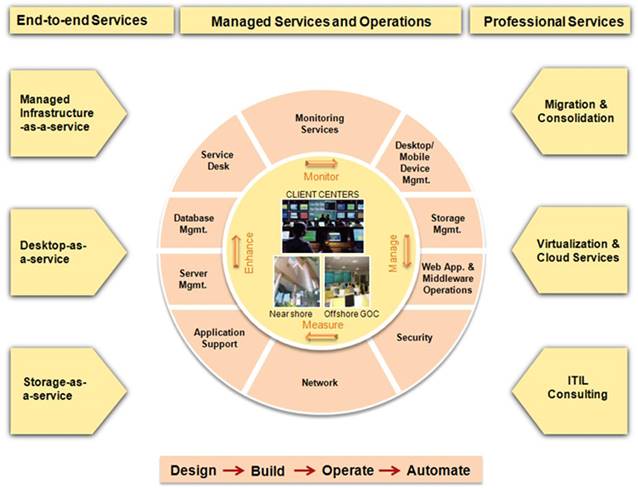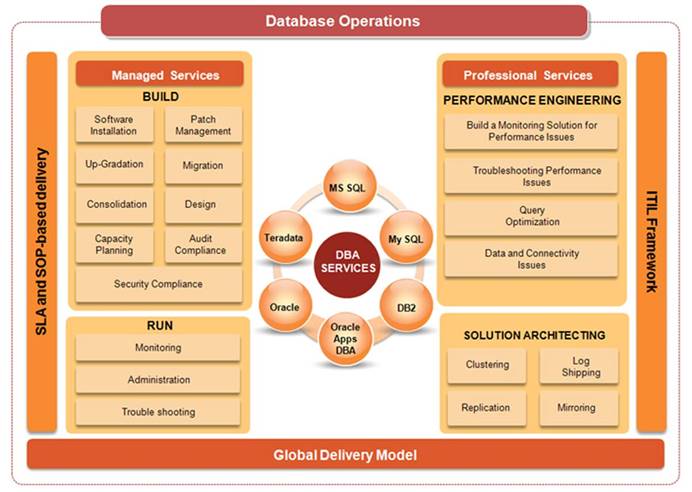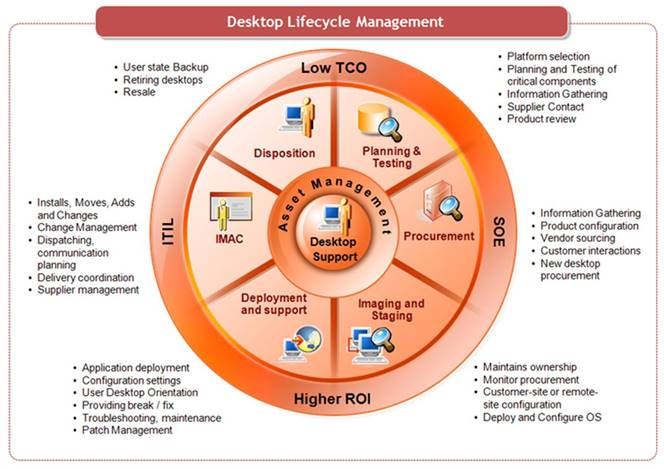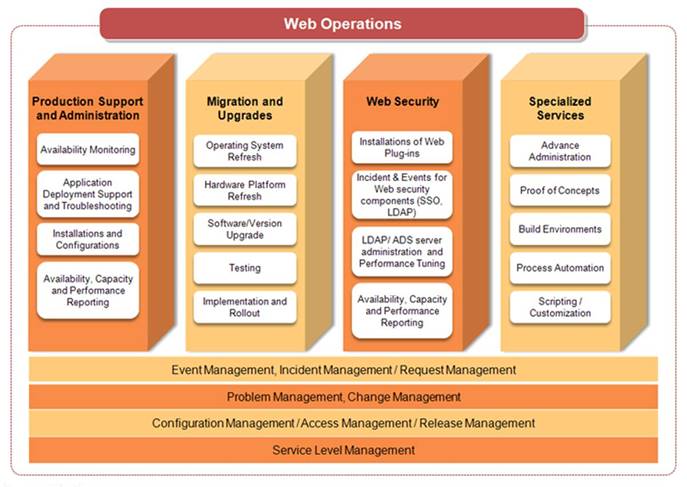Infrastructure Management
Overview
In today’s volatile business world, enterprises face significant challenges in scaling and managing their global IT infrastructure. To meet these challenges, ERP Global offers focused solutions in core infrastructure areas for building and managing the enterprise IT infrastructure comprising lifecycle services in datacenter management, desktop management, database administration, and web operations. ERP Global’s domain expertise spans a diverse set of systems and technologies within an organization’s enterprise IT infrastructure.
Enterprises can achieve cost efficiencies and accelerated time-to-delivery by leveraging ERP Global’s robust global delivery model, proven methodologies, standardized tools and mature processes for enterprise infrastructure management services (IMS). ERP Global offers focused solutions in core infrastructure areas and leverages its proven IT infrastructure assessment tool and methodologies to design solutions that are closely aligned to the client’s business strategy.
Our comprehensive, industry-leading portfolio of infrastructure management services guarantees high reliability, round-the-clock availability, remote manageability, and optimum scalability. Our domain expertise spans diverse set of systems and technologies. Client’s can leverage ERP Global’s offshore service delivery centers to avail proactive and cost-effective solutions and gain quick return on IT infrastructure investments.

Expertise
ERP Global offers competencies across multiple technology platforms, software products, and management tools with a strong focus on providing secure and scalable solutions. We provide end-to-end services and solutions designed to reduce TCO and quicken ROI. ERP Global has adopted an ITIL- based service delivery model to ensure increased availability and system efficiency.
Technology Expertise
ERP Global’s expertise spans the diverse set of systems and technologies that comprise today’s enterprise IT infrastructure. We offer infrastructure solutions and services for designing, building and managing the enterprise IT infrastructure including data centers, databases, desktops and the Web. We provide consulting, design, implementation and ITIL V3 complaint managed services to ensure peak system performance. Through an initial infrastructure assessment, ERP Global identifies potential gaps in the client’s existing infrastructure, environment support, avenues for upgrade/migration, and opportunities to standardize infrastructure, restructure and balance resource loads to improve overall performance.
Functional Expertise
ERP Global leverages its technical expertise and global delivery model to offer IT infrastructure solution and support services to various industry segments including financial services, insurance, manufacturing, media, utilities, distribution, etc. ERP Global’s functional expertise extends across all facets of IT Infrastructure Management Services. This enables us to deliver industry-focused solutions that can be tailored to our client’s business needs.
Data Center Opertions
Once considered the showcase of IT, datacenters are now perceived as operational boat anchors – considered a purgatory by IT professionals and a CAPEX money pit by the CFO and finance. The recent economic downturn and ensuing recession are to blame for this. In an effort to cut costs anywhere, executive management eventually turned their sights to IT and the glass house and told the CIO to find a more cost effective approach to support the business. In this regard, outsourcing has been a logical alternative. ERP Global offers traditional professional services such as those depicted along with mature processes and methodologies that leverage its global delivery model to both drive down support costs for its customers while delivering against SLAs.
Today, we deliver these services in the context of a consulting engagement which take clients through an assessment exercise designed to align IT operations with business requirements that results is a more holistic view of IT resources. These are then further optimized using state of the art transformation approaches such as cloud computing, virtualization, legacy modernization and master data management which delivers resources on demand at significantly lower costs – which for some customers can reach as high as 70% depending on the size of their data center and assets involved.

Server Management
- Server monitoring and reporting – covers all operational parameters done onsite or remotely with tools that provide utilization, performance and availability reports.
- Administration and troubleshooting of servers/ services – includes all aspects of relevant ITIL processes
- Install/ upgrade/ patching of servers – covering a broad range of operating systems includes full system backup after an initial installation
- Server security & hardening – highly customized capabilities, updated as threats evolve to ensure that critical resources have up-to-date patches and are able to defend against known vulnerabilities
- Backup, recovery and job scheduling – this includes full, incremental or cumulative approaches covering clients, servers and storage units
Network Management
- Network Monitoring and Reporting – goes beyond 24×7 monitoring to include proactive problem identification and resolution of a enterprise IT environment, historical trend information and up-to-date performance snapshots.
- Administration and troubleshooting of devices & services – Automated procedures and analytics identify and fix potential problems before performance is affected.
- Install/ upgrade/ patching of devices – including all associated administrative services such as adds, moves and changes
- Network security and hardening – approaches include the use of the latest standard IPS/IDS devices to monitor all network end points
- Configuration and backup management – including service restoration, image maintenance and rollbacks
Storage Management
All listed capabilities support a range of deployment models including RAID, SAN, Virtualization and cloud.
- Storage monitoring and reporting – covers all operational parameters done onsite or remotely with tools that provide utilization, performance and availability of all storage resources.
- Administration and troubleshooting – includes automated operations and analytics based on thresholds and triggered events
- Install/ upgrade/ patching – including all associated administrative services such as adds, moves and changes
- Security & hardening – covers the removal of vulnerable and unnecessary services, patching security holes, and securing access controls.
- Configuration and backup management – including cloud based and deduplication approaches
Infrastructure Application Management
- Application monitoring and reporting – supporting all operational parameters including usage, throughput and availability
- Administration and troubleshooting – includes automated operations and analytics based on thresholds and triggered events that can offline, initialize and restart an application without operator intervention
- Install/ upgrade/ patching – including version management and remote distribution
- Security & hardening – covers the removal of vulnerable and unnecessary services, patching security holes, and securing access controls
- Configuration and backup management – includes activities such as the creation and management of separate instances to reduce application downtime
Database Administration
Arguably, the most important aspect of IT operations – and the one that is the most complex – is database operations and a supporting master data management architecture. The lack of a well thought out architecture can lead to inaccurate record keeping effecting customer satisfaction – and if not addressed – lost business. With cloud technologies gaining acceptance as a preferred deployment model, the need for well thought out data architectures that takes into consideration distributed resources, industry specific compliance and security requirements becomes even more crucial and problematic.

Our offerings can assist corporations in designing and implementing solutions that will enable them to take advantage of the latest technologies while ensuring consistency. Our frameworks are designed to integrate disparate data sources creating data warehouses that have consistent, accurate and up-to-date information. This approach enables the use of value added services from ERP Global such as analytics and business intelligence for forecasting, modeling and growth.
- Production Services– – includes managing and monitoring mission critical databases, and standardizing business rules and procedures across the organization and implementing industry best practices .
- Application Services–
- Database design – consulting services for creating architectures that integrate disparate application structures providing consistency for accurate data capture and reporting.
- Database refreshes – full support for all proscribed procedures from leading database providers such as Oracle, Sybase, SQL Server and DB2 UDB
- Security and audits – Covers the design, implementation and monitoring secure infrastructures to initiating pre-defined responses to cyber crime incidents.
- Deployment and administration – global rollout services via a wide range of methods including public and hybrid cloud
- Query tuning and performance – models the expected usage of a system by simulating multiple users accessing the system concurrently. Offeriong covers databases related, application servers related, user interfaces related
- Consulting – Full suite of assessment and design services covering all aspects of database rollouts, implementations, integration and sustaining activities from both an IT and business process perspective
Remote Managed Services – Running the Infrastructure
Global network operation centers (NOCs) are the cornerstone of our service delivery architecture. These state-of-the-art facilities highlight ours rigorous standards of full redundancy, high availability, and uncompromising security. Our comprehensive range of remote infrastructure management services give our customers the ability to reduce costs and improve service levels. Customers can implement a complete remote service desk solution or simply start with remote monitoring for a portion of their network, a select site, or a group of servers. Additional remote infrastructure management services can easily be added as needs change. Remote infrastructure management solutions are based on a sophisticated architecture that is open and scalable and which enables the integration of vendor or customer-supplied tools – eliminating a task that stymies most companies. As a result, we provide clients with a consistent, consolidated management view of their environment.
By delivering remote infrastructure management services from our NOC, we have helped many global enterprises cut down their costs of infrastructure management and gain access to expert skills. Each NOC supports multiple monitoring consoles that proactively manage remote client environments and over 10,000 applications, databases, or servers, as well as 20,000 SNMP devices. These monitoring consoles are scalable and replicable to ensure faster service deployment and swifter problem resolution for even the largest customer.
Remote Monitoring
Our company provides automated, continuous, 24×7 availability and performance monitoring of the client’s environment. We monitor IT components and transactions for specific events, threshold violations and errors/faults, based on pre-defined metrics. Our remote monitoring service automatically notifies the customer or designated service provider when events defined by the customer are detected. Our clients have the option of choosing how problems are resolved and who is responsible for solving them. Notification includes an escalation and tracking process as determined by the client. We collect and store up to fifteen months of historical information to facilitate trend analysis and IT planning. Our remote monitoring service helps to maximize performance, significantly enhance service levels and immediately reduce downtime.
Remote Infrastructure Management
Our remote infrastructure management solution goes beyond 24×7 monitoring to include proactive problem identification and resolution. Built-in root cause analysis helps to identify and automatically fix potential problems before performance is affected. Our remote infrastructure management solution will automatically carry out clients’ pre-specified instructions to fix problems such as restarting sluggish servers and the applications that reside on them without human intervention. The solution can also automatically dispatch on-site service providers to address high priority issues. By automating corrective actions, IT organizations decrease problem resolution time and improve system availability.
Remote Operations
The company’s remote operations service combines remote infrastructure management capabilities with the power of service level management to deliver the quality of service your business demands – guaranteed! Our remote operations solution automates the process of IT infrastructure administration, including patch management. ERP Global can manage maintenance schedules and administrative tasks such as resource assignments and notification options, depending on the level of service desired. Above all, we provide flexibility. We can handle scheduling, notification, and other administrative tasks or self-manage those tasks via the Web through our secure Customer Portal. Self-service scheduling saves time and allows organizations to easily manage notification and escalation schedules via the Web, 24×7. The solution enables organizations to add, move, or change IT components without disrupting service to users or requiring resources to work off-shift. ERP Global’s operations experts can analyze performance trends and proactively identify capacity requirements so that IT infrastructure keeps pace with business growth, helping our clients to meet the service demands of their organizations.
Remote Service Desk
Remote service desk provides complete 24×7 help desk coverage – from call management to service request tracking to problem ticket management to change request management. Our remote service desk is a cost-effective alternative to in-house service desk applications. During implementation, we work with clients to complete a series of templates and workflow definitions to establish fully functioning trouble ticketing and detailed service reporting enabling IT organizations to validate their service level agreements. A searchable knowledge base expedites problem solving so that client issues are resolved faster and more efficiently. Service tickets are automatically generated for those events that have been pre-defined – up to and including automatic notifications by phone, email, or pager. A web interface also allows ERP Global and customers to enter and track trouble tickets and service requests from anyplace via the Internet while our service desk solution tracks all incidents until resolved. Remote service desk solutions are provided through its global NOC centers, making it easy to provide round-the-clock service and ensuring that issues are addressed in a timely manner, no matter where they occur.
Customer Portal
Every remote infrastructure management solution provided includes a secure, customer-specific, Web-based management portal. Our remote infrastructure management services give our clients a transparent and clear view of the availability, utilization and performance of every IT component of the infrastructure. Clients can see how their infrastructure is performing 24×7 and get historical trend information or the latest performance snapshot at any time. In addition, a built-in scheduling area gives clients an immediate view of notification and escalation schedules for problem resolution. Eighty different reports are provided ranging from high-level executive summaries to end-user usage reports totechnical views for IT managers. Point and click navigation simplifies online administration and viewing, making it easy for users to see the information relevant to them or their part of the infrastructure. More detailed information about specific events or objects is a simple mouse-click away. Customers have the freedom to choose what information they want, how much information they get, and what that information looks like. Reports can be presented in a graphical format, printed, emailed or exported to any other reporting tool you may use (e.g. Excel, Access).
Desktop Operations – Desktop Lifecycle Management
The increasing adoption of hosted virtual desktops (HVDs) by enterprises will have a profound effect on IT operations. According to industry analysts, the market for HVD will reach $65.7B by 2013 and will comprise more than 40% of the worldwide professional PC market at that time. This trend will have a fundamental impact on IT desktop operations – shaping everything from PC purchasing strategies to application delivery, maintenance and security.

ERP Global’s desk top practice for lifecycle management can serve as a critical resource to CIOs planning HVD rollouts. Our Desktop Computing Center of Excellence (DCCoE) continuously works with emerging technology and technology leaders such as Microsoft to ensure that our frameworks, processes and global delivery model are capable of supporting any deployment model a customer may choose. This includes the creation of Standard Operating Environments (SOEs) and ITIL-based deployment plans which can be used for designing and implementing HVD environments. Because we use a global delivery model, customers are guaranteed of receiving these services cost effectively – no matter where their business operations are.
Total Cost of Ownership
Disposition
- User data backup, restoration and migration – similar to services provided for enterprise data storage and management
- Retiring desktops – including tools, processes and methodologies for cost-effective asset management
- Resale
Planning and Testing
- Platform selection/upgrade
- Planning and Testing of critical components
- Information Gathering
- Supplier Contact
- Product review
SOE
Procurement
- Information Gathering
- Product configuration
- Vendor sourcing – use of structured methodologies with scorecards that drive selection criteria
- Customer interactions
- New desktop procurement
ROI
Imaging and Staging
- Monitor procurement
- Customer-site or remote-site configuration – see remote infrastructure section for complete listing of offerings
- Deploy and Configure OS – Microsoft Desktop Deployment Partner (DSP), with expertise in supporting Fortune 10 client environments
Deployment and Support
- Application deployment – as with OS, including package creation and testing
- Configuration settings – done pre-implementation for swifter distribution
- Desktop Deployment Readiness Assessment and Orientation – readiness includes full review of supporting infrastructure as well as the creation of a database that catalogs all information required to track an IT asset
- Providing break/fix – full suite of remedial services
- Troubleshooting, maintenance – automated operations with available 24/7 help desk support for quick problem resolution
- Security and Patch Management – automated software distribution with zero touch which covers the removal of vulnerable and unnecessary services, patching security holes, and securing access controls, application security patches or service packs, removing default folders and components
ITIL
- Installs, Moves, Adds, Changes (IMAC)
- Change Management – includes, but not limited to, prioritizing requests, information gathering, scheduling, planning, testing and validating
- Dispatching, communication – including impact reports
- Planning
- Delivery coordination
- Supplier management
Web Operations
It wasn’t too long ago that website operations was just another term for website development and management. While a companies website is still the focal point of its on-line presence, the transition of the web from a place to find information to a fully featured market place has had a profound impact on company strategies in this area. Instead of static storefronts that dispense information, sites need to be engaging – establishing a dialog with visitors that keeps them interested in understanding more about what a company has to offer. For IT, this means web operations that incorporate social networking approaches that interact with clients using mechanisms of their choice that provide them with the opportunity to interact and the incentive to come back and conduct business.
ERP Global provide a comprehensive suite of specialized services that take companies through a process that identifies the business objectives and the IT architectures, social media strategies, on-line market place alternatives and implementation plans needed to make it happen. Once done, we implement a complete range of support capabilities that cover every aspect of the web operations lifecycle.
Production Support and Administration
- Availability Monitoring
- Application Deployment Support and Troubleshooting Installations and Configuration
- Availability, Capacity and Performance Reporting
Migration and Upgrades
- Operating System Refresh
- Hardware and Platform Refresh
- Software/Version Upgrade – also includes integration architectures to support site consolidation requirements
- Testing –including performance load and user acceptance testing; integration testing with external applications and disaster recovery
- Implementation and Rollout – covering, but not limited to, portal rollout, system cutover (such as WCM environments), syndication configuration and unit testing
Web Security
- Installations of Web Plug-ins – to support a wide range of additional social networking requirements including support for mobile device access
- Incident and Events for Web security components (SSO, LDAP)
- LDAP/ ADS server administration and Performance Tuning
- Availability, Capacity and Performance Reporting
Specialized Services
- Advanced administration – which includes the ability to design, implement and integrate corporate wide procedures such as SSO
- Proof of concepts – covering any aspect web operations from authoring to delivering
- Build environments – including architectures and rollouts for site consolidations and refresh
- Process automation
- Scripting/customization – customized workflows, methodologies and tools which speed the development, review and implementation of new website content including the use of automated tools and templates
